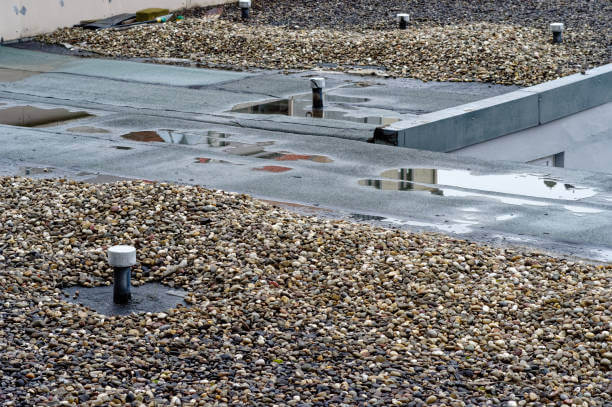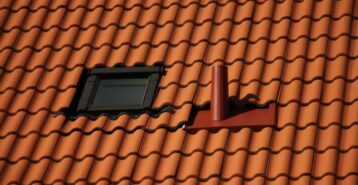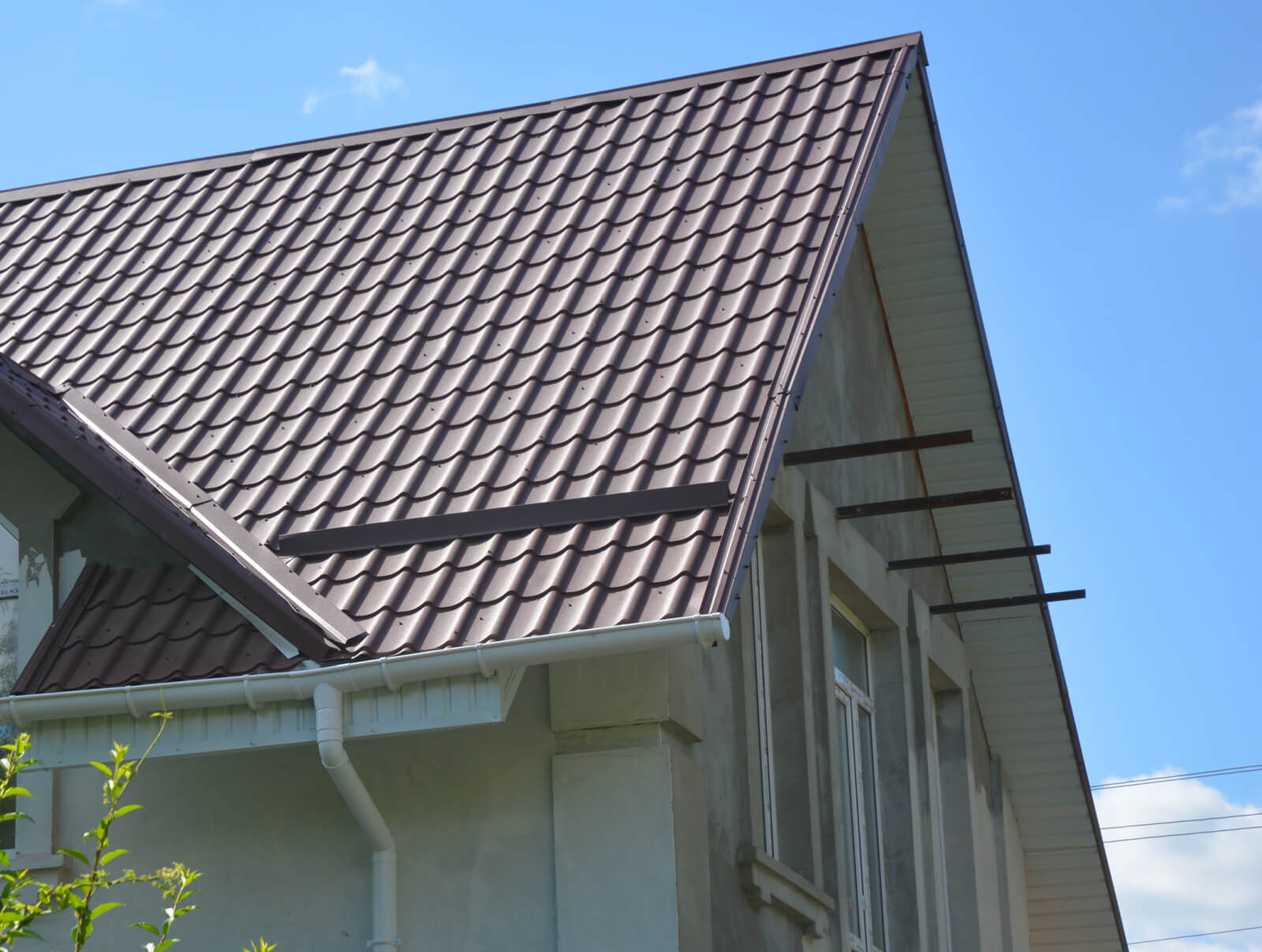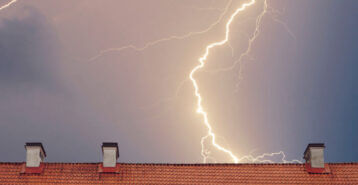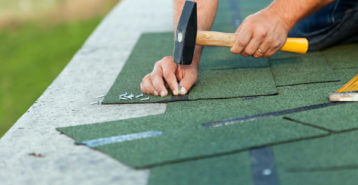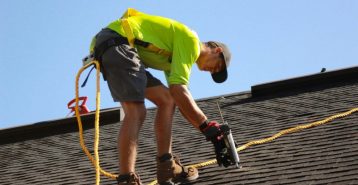What Is a Tar and Gravel Roof?
A tar and gravel roof, also known as Conventional Built-Up Roofing (BUR), is a common roofing system used on flat and low-slope roofs. It’s made by layering roofing felt or fiberglass with hot asphalt (tar), followed by a protective top layer of gravel. This type of roofing has been around for over 100 years and is known for its strength and cost-effectiveness.
If your home or business has a flat roof, a tar and gravel system may be an excellent choice. It’s especially popular in warm, dry climates where heavy rainfall or snowfall is less common.
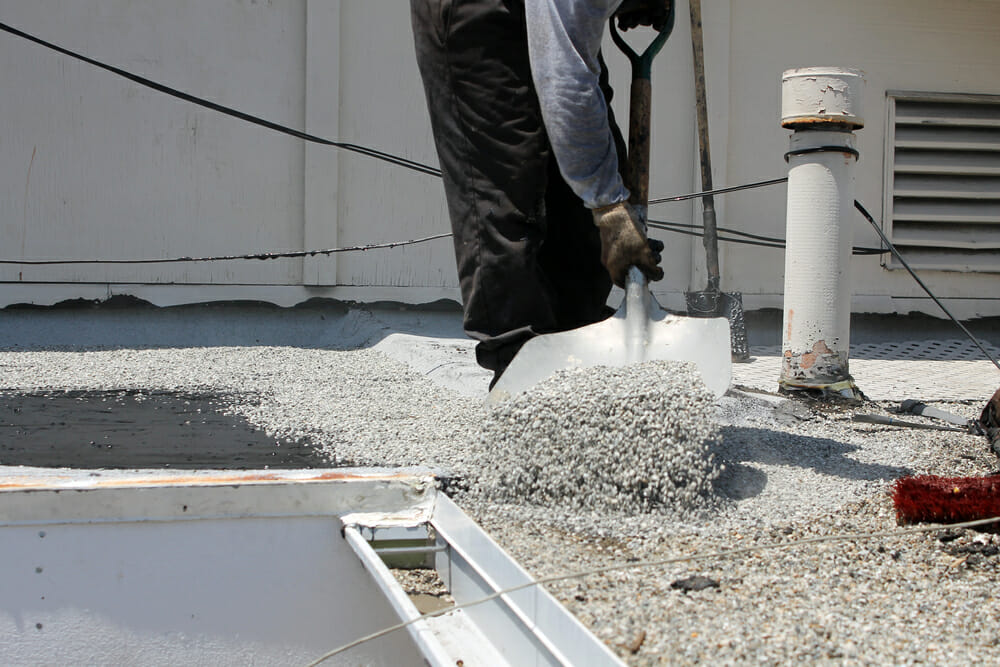
Average Cost of Installation
You can expect to pay between $7,500 and $13,500 to install a tar and gravel roof, depending on the size and complexity of your roof. That’s about $2.50 to $4.50 per square foot, or $250 to $450 per square. These estimates are based on a 3,000-square-foot roof. Other factors that affect the cost include:
- Roof pitch and slope
- Number of layers needed
- Type and weight of gravel
- Local labor rates
- Roof access and prep work
Because this roofing type is heavy, your roofing contractor may also recommend reinforcing your home’s structure before installation.
Cost by Roof Size
The cost of a tar and gravel roof depends heavily on the size of your roof. Larger roofs require more materials and labor, but the cost per square foot generally stays within the same range. Below is a table showing the average price range for different roof sizes, based on the standard rate of $2.50 to $4.50 per square foot:
| Roof Size (Square Feet) | Average Cost (Materials + Installation) |
|---|---|
| 1,500 | $3,750 to $6,750 |
| 2,000 | $5,000 to $9,000 |
| 2,500 | $6,250 to $11,250 |
| 3,000 | $7,500 to $13,500 |
These are rough estimates. Your final cost may vary based on the roof’s condition, slope, labor rates in your area, and any additional work like structural reinforcement or debris removal.
Types of Tar and Gravel Roofing
There are two main variations to choose from:
Modified Bitumen BUR
Modified bitumen roofing systems are an evolution of traditional built-up roofing (BUR). They consist of asphalt that has been modified with rubber or plastic polymers, such as SBS (styrene-butadiene-styrene) or APP (atactic polypropylene), to improve flexibility and weather resistance. These materials are typically reinforced with fiberglass or polyester mats for added strength. While they may be installed in multiple layers like BUR, some systems are applied as a single membrane. The roof is often topped with a gravel layer or reflective coating to protect against UV damage and add durability.
Ballast Roof Systems
Ballast roof systems use large, loose stones, usually river rock or crushed stone, to weigh down a roofing membrane rather than adhering it directly to the roof deck. This system is typically used with single-ply membranes like EPDM, TPO, or PVC. The gravel provides wind resistance, UV protection, and fire resistance without the need for adhesives or fasteners. Ballasted systems are commonly found on commercial buildings due to their ease of installation, energy efficiency, and relatively low cost.
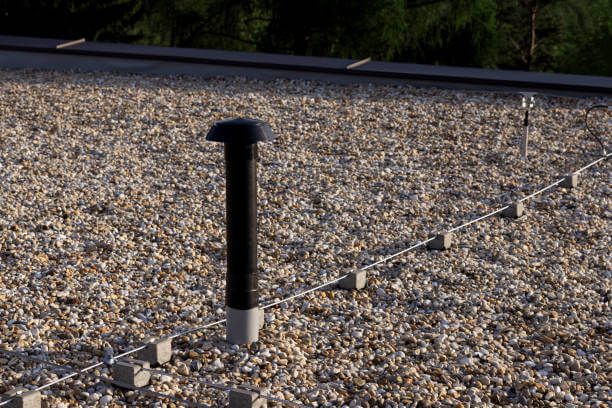
Benefits of Tar and Gravel Roofing
- Budget-friendly: It’s one of the most affordable flat roofing systems.
- Durable: Lifespan can range from 20 to 30 years with proper care.
- UV Protection: Gravel reflects sunlight and shields roofing materials from sun exposure.
- Fire Resistance: Offers Class A fire resistance with the right materials.
- Soundproofing: The thick, layered design helps reduce outdoor noise.
- Low maintenance: Needs less frequent repairs compared to some alternatives.
Maintenance and Repairs
Proper maintenance is the key to getting the most life out of your tar and gravel roof. With routine care, these roofs can last up to 30 years. While they’re known for their durability, neglecting regular upkeep can lead to early deterioration and costly repairs.
Regular Maintenance Tasks
A few regular maintenance tasks can help you extend the lifespan of your tar and gravel roof:
1. Inspect the Roof At Least Once A Year: At least once a year, and after major weather events, you should inspect the roof for signs of wear or damage.
2. Check the Gravel Layer and Cover Bald Spots: One of the most important tasks is checking the gravel layer. If you notice bald or uneven spots, it’s important to redistribute or add gravel to keep the roofing materials protected from UV rays and water damage.
3. Clear Off Debris: You should also clear off leaves, dirt, and debris that can trap moisture and lead to ponding. Since flat roofs don’t drain as efficiently as sloped ones, standing water can create depressions or even structural issues over time.
4. Apply New Protective Coatings: Applying a new protective coating every few years can also help extend your roof’s lifespan. Many homeowners use acrylic or elastomeric coatings to create a “cool roof” surface that improves energy efficiency and helps prevent leaks. These coatings can also refresh older roofs and act as an extra line of defense against the elements.
Repair Costs and Considerations
Repair costs for tar and gravel roofs vary depending on the extent of the damage. Minor repairs like patching small cracks or adding gravel can range from $300 to $600. Larger repairs, such as addressing areas with water damage, replacing deteriorated membrane sections, or reapplying top layers, may cost $1,000 to $2,500 or more. If the roof has widespread damage or over 25% is patched, a full replacement may be more cost-effective.
Common Issues and How to Avoid Them
Even though tar and gravel roofs are reliable, they’re not without challenges:
- Ponding Water: Flat roofs can hold water for more than 48 hours if drainage is poor. This can cause structural damage over time.
- Blistering and Cracking: Improper installation or extreme weather can lead to blistering and cracking.
- Vegetation Growth: Pooled water may encourage moss and weeds, which can damage the surface.
- Hidden Leaks: It can be hard to trace leaks through the layers of the roof without professional tools.
When Tar and Gravel May Not Be Right
While tar and gravel roofs can be a good option for certain homeowners, this roofing system might not be a good fit if:
- You live in an area with heavy snow or rainfall
- Your home can’t support the added weight
- You need a roofing option that’s quick and easy to repair
- You’re looking for a DIY-friendly solution
Final Thoughts
A tar and gravel roof offers excellent protection, great value, and a long lifespan when installed and maintained properly. It’s a strong choice for homeowners with flat roofs, especially in sunny, dry areas.
Still not sure if it’s the right fit for your home? We can connect you with trusted local roofing contractors who can inspect your roof, explain your options, and help you choose the best system for your climate and budget.
FAQ: Tar and Gravel Roofs
How long does a tar and gravel roof last?
A tar and gravel roof can last 20 to 30 years with proper care and maintenance. Regular inspections, gravel redistribution, and protective coatings can help extend its lifespan. Without routine upkeep, the roof may deteriorate sooner due to UV exposure, water pooling, or surface damage.
How much does a tar and gravel roof cost?
The average cost to install a tar and gravel roof ranges from $7,500 to $13,500 for a 3,000-square-foot roof, or about $2.50 to $4.50 per square foot.
Can you walk on a tar and gravel roof?
Yes, you can walk on a tar and gravel roof, but with caution. The gravel provides some protection, but stepping on loose stones can shift the surface and damage the layers beneath. It’s best to walk gently, wear soft-soled shoes, and avoid disturbing the gravel more than necessary.
What is the best replacement for a tar and gravel roof?
The best replacement for a traditional tar and gravel roof depends on your needs, but common alternatives include:
- Modified bitumen roofing – similar look and function, but improved flexibility and resistance
- TPO or EPDM single-ply membranes – lighter, energy-efficient options for flat roofs
- Ballasted roof systems – use loose stone over a membrane, like EPDM, for UV and wind protection
These alternatives offer better performance in extreme climates and may require less maintenance over time.
Can a tar and gravel roof be repaired?
Yes, a tar and gravel roof can be repaired. Small issues like cracks or bald gravel spots are often resolved with patching or re-coating, typically costing $300 to $600. Larger repairs involving water damage or membrane replacement may run $1,000 to $2,500. If more than 25% of the roof is damaged, a full replacement is usually more cost-effective.


